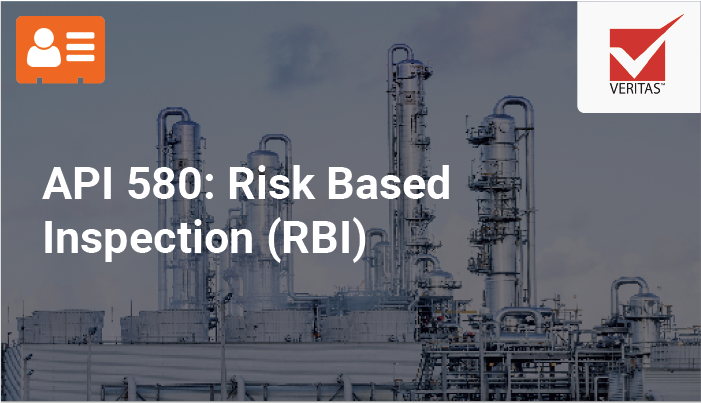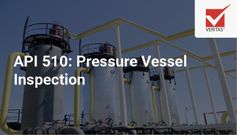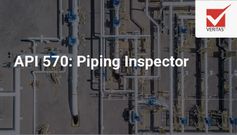API 580: Risk Based Inspection (RBI)
Join the Program
Price: €950
Registration deadline: 15 July 2024
18 hr Content/3 Day Program
19 Credits
Dr Igor Martic & Dr Lazar Jeremić
VILT1305
Format:
Instructor-led
"Dates and Payments will be arranged with you after the registration deadline. Register today!"
Reduced fees with a team account
Contact us to discover the benefits of a team account
Prefer a private in-company training?
Contact us to arrange one for this course
Course Objective
“To provide participants with the skills and knowledge to develop, implement and sustain a Risk Based Inspection (RBI) program as defined in API RP 580.”
Virtual Instructor-led
100% online training
Video Lectures by Experts
connect with them online
3 Days
2 sessions per day
PDH Hours qualified course
Read more here
About the course
Instructor-led
6 Live sessions
3 Days
Registration deadline
15 July 2024
3hr/session
English
Limited seats
VILT1305
Managing risk is a essential part of operating a facility or production process safely and cost effectively. The API RP 580 introduces the steps needed in an Risk Based Inspection (RBI) program and provides guidance on how to implement these in practice.
This 3 day instructor led virtual training course provides participants with a clear and thorough understanding of the basic elements for developing, implementing and sustaining an effective Risk Based Inspection (RBI) program as defined in API RP 580. The training course starts with the definition of RBI and explains the key elements. Participants are then shown how to implement RBI and how the RBI program once established can be sustained long term.
The course consists of 6 instructor led sessions spread across three days. All training content is provided through your EngineeringTrainer account.
After the course you maintain 1-year unlimited access to the course, including any new course material. This allows you to perform modules again should you need to refresh your knowledge.
Meet your instructor
Program & Details
Risk Management and Risk Reduction
Risk Analysis
Inspection Optimization
Relative Risk vs Absolute Risk
Key Elements and Types of RBI Assessment
Precision vs. Accuracy
Understanding how RBI can help to Manage Risks
Relationship with Other Risk-Based and Safety Initiatives
Establishing the Objectives and Goals
Initial Screening
Establish Operating Boundaries
Selecting a Type of RBI Assessment
RBI Data Needs
Data Quality
Codes, Standards and Site Specific Data
Some Special Cases
Protecting Sensitive Equipment
Probability Analysis
Determination of POF (Probability of Failure)
Consequence Analysis
Volume of Fluid Released
Consequence Effect Categories
Determination of the COF (Consequence of Failure)
Determination of Risk
Risk Management
Sensitivity Analysis
Assumptions
Establishing Risk Thresholds
Managing Risk through Inspection
Identifying Risk Management Opportunities from RBI Results
Establishing an Inspection Strategy Based on Risk Assessment
Managing Risk with Inspection Activities
Managing Inspection Costs with RBI
Assessing Results and Determining Corrective Action
Equipment Replacement and Repair
Evaluating Flaws for Fitness-For-Service
Equipment Modification, Redesign and Rerating
Emergency Isolation and Depressurizing
Modifying the Process
Integrity Operating Windows
Reduce Inventory
Water Spray/Deluge or Water Curtain
Blast-resistant Construction
Why and when to conduct an RBI Assessment
Team Approach, team members
Training and Qualification for RBI Application
RBI Methodology and Personnel
Timeframe
Basis for Assigning Risk and Assumptions
Results, Mitigation and Follow-up
Planning, Data and Information Collection
Damage Mechanisms and Failure Modes
Assessing POF and COF
Risk Determination, Assessment and Management
Risk Mitigation Activities
Roles, Responsibilities and Documentation
Results
After this course, you...
have a good overview of Risk Based Inspection (RBI) in accordance with API RP 580, and understand the reasons for implementing RBI.
understand how to implement and sustain an RBI program and have seen the essential elements as defined in API 580.
know what is meant by practical likelihood and can perform a consequence analysis.
have seen how to preparing inspection plans and how maintenance and inspection intervals can be safely optimized.
understand the essential elements for an RBI assessment program as defined in API 580.
have the skills to contribute to the implementation and sustaining of an RBI program within your organisation.
have an overview of how other procedures (e.g. RIMAP, ASME) and related API documents (API 510, API 570 and API Std 653) relate to an RBI program.
Who should attend this course
Engineers, inspection personnel, and maintenance personnel involved with corrosion, process safety, mechanical integrity
Inspectors who are already certified as per API 510, API 570, or API 653, and work for organizations with RBI programs
Individuals who are interested in obtaining API 580 certification can utilize this course to supplement their exam preparation efforts
Prerequisites:
Affinity with plant maintenance and operation
Level: Intermediate
This course consists of 6 instructor-led live sessions which consist of presentations, demonstrations, discussions and worked cases. During each session, participants can ask questions to the instructor (through the chat or microphone) which will be answered in the session.
Access to the course
After signing up for the course, EngineeringTrainer will be in touch shortly after the Registration Deadline to agree a training schedule that is possible for the participants and instructor. Payment will also be arranged at this stage after the Registration Deadline.
Once the training schedule is agreed, you will find the course welcome chapter and instructions on how to join the live sessions in your EngineeringTrainer portal.
Sessions are held using the software Microsoft Teams and a log-in link is provided for each session through the EngineeringTrainer portal. Live sessions can be joined using any device, including tablets and mobiles.
There is a Registration procedure for this training course. Please click on the register button above to register.
Shortly after the Registration Deadline has passed EngineeringTrainer will be in touch to agree a training schedule which is possible for you, typically within 2 months of the Registration Deadline.
No payment is required until after the Registration Deadline. Payment will be arranged together with the schedule after the Registration Deadline.
Typically the course will be split across 8 sessions, an example is shown below, the final date and schedule of the training course will be determined together with the instructor and the participants after the Registration Deadline :
Session 1: 3hr
Session 2: 3hr
Session 3: 3hr
Session 4: 3hr
Session 5: 3hr
Session 6: 3hr
These session will include beaks at regular intervals
A personal digital certificate will be made available to each participant upon full attendance.
Example Certificate:
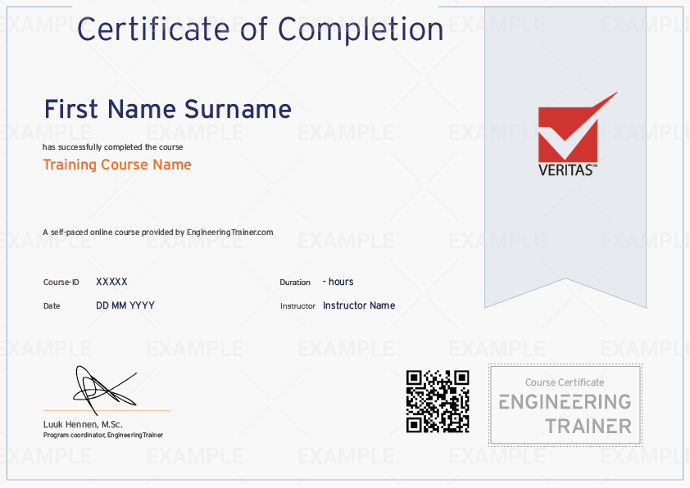
FAQ
This course consists of instructor-led live sessions which consist of presentations, demonstrations and discussions of questions. During each live session participants can ask questions to the instructor (through chat or microphone) which will be answered.
Please note that for privacy reasons no recordings of the live sessions are made or provided.
The training material used in the live sessions, for example the slides or exercises, will be available in the EngineeringTrainer portal for a year after the date of the training allowing you to refresh your knowledge or review material if needed.
No, course content is not available for download.
The training material used in the sessions, for example the slides or exercises, will be available in the EngineeringTrainer portal for a year after the date of the training allowing you to refresh your knowledge or review material if needed.
Please note that for privacy reasons no recordings of the live sessions are made or provided.
Yes, interactive Q&A sessions are part of the live sessions in this course and allow you to interact with the instructor and ask questions.
To respect the privacy of the participants the live sessions will not be recorded, and as such the live sessions cannot be played back. Therefore it is important for all participants to block the time slots of the live sessions in their calendars and be present.
No software licenses are provided as part of this course.
Yes, this course qualifies for PDH hours as per the NCEES CPC Guidelines.
Related Courses
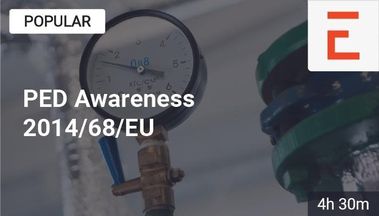
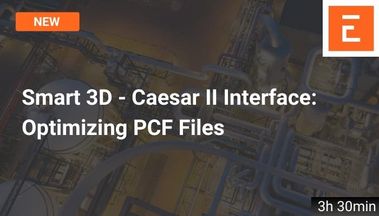
Virtual Training
Smart 3D - Caesar II Interface: Optimizing your Caesar II Model Building through PCFs
By: Gerónimo Zamora García
Program & Details
Course Welcome
-
Welcome to the course
-
Your instructor
-
How to use this course
-
Personal Certificate requirements
Module 1: Valve Fundamentals
-
The purpose of using and actuated valve
-
Describing the application
-
Actuated on/off valves
-
Control valves
-
Self-actuating regulators
Module 2: Operation and Maintenance
-
Criticality
-
Lifecycle conditions
-
Maintainability
-
Maintenance strategies
-
Operational safely
-
Leak detection and repair
-
Failure Modes
Module 3: Overview of Valve Styles
-
The 2 fundamental construction types
-
Rotary motion valves
-
Linear motion valves
-
Variations
Module 4: Requistioning
-
Data/requisition sheet
-
Common aspects
-
Ingress protection
-
Electromagnetic compatibility
-
Hazardous areas
-
Type acceptance training
-
Inspection and test plan (ITP)
-
CE marking
Module 5: Actuated Valve Manufacturing
-
QA/ QC
-
Inspection and testing
-
Documentation
-
Painting
-
Acceptance testing
Final Notes
-
Congratulations
-
Course evaluation survey
-
Your Personal Certificate
-
Welcome to the course
-
Your instructor
-
How to use this course
-
Personal Certificate requirements
-
The purpose of using and actuated valve
-
Describing the application
-
Actuated on/off valves
-
Control valves
-
Self-actuating regulators
-
Criticality
-
Lifecycle conditions
-
Maintainability
-
Maintenance strategies
-
Operational safely
-
Leak detection and repair
-
Failure Modes
-
The 2 fundamental construction types
-
Rotary motion valves
-
Linear motion valves
-
Variations
-
Data/requisition sheet
-
Common aspects
-
Ingress protection
-
Electromagnetic compatibility
-
Hazardous areas
-
Type acceptance training
-
Inspection and test plan (ITP)
-
CE marking
-
QA/ QC
-
Inspection and testing
-
Documentation
-
Painting
-
Acceptance testing
-
Congratulations
-
Course evaluation survey
-
Your Personal Certificate
